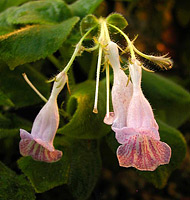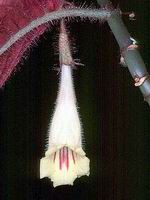
Ron Myhr, The Gesneriad Reference Web
http://www.gesneriads.ca;
cult. RBG Edinburgh, phot. R. Myhr
Full name and orig. publication: Raphiocarpus Chun, Sunyatsenia 6: 273 pl. 44 & fig. 32 (8 Nov. 1946).
Etymology: From the Greek ραφις, raphis = needle, and καρπος, karpos = fruit, alluding to the fruit, a very slender cylindrical capsule.
Synonym: Didissandra sect. Chiritoides K.Fritsch (1894).
Infrafamilial position: Didymocarpoid Gesneriaceae - "Advanced Asiatic and Malesian genera" (Weber 2004).
Description: Shrubs, subshrubs or perennial herbs, in R. sesquifolius with a distinct underground rhizome and annual shoots. Leaves opposite, the pairs well-spaced or tufted at the stem apex, the leaves of a pair equal or (partly strongly) unequal, petiole present or absent, lamina ovate or broadly lanceolate, base cuneate to cordate. Cymes axillary, 1- to several-flowered, flowers lax or dense. Sepals 5, free or connate. Corolla usually large, tube long, tubular to funnel-shaped and widening above, limb bilabiate, upper lip 2-lobed, lower lip 3-lobed, lobes rounded, coloration variable. Stamens 4, inserted near or above the middle of the corolla tube, included; anthers (?always) coherent, with divergent thecae, dehiscing by longitudinal slits; staminode present or lacking. Nectary ring-shaped. Ovary slender, unilocular; stigma entire or bilobed. Fruit an elongated capsule, dehiscing longitudinally into two valves.
Chromosome number: Unknown.
Species number: 11, a few more to be described.
Type species: Raphiocarpus sinicus Chun
Species names (incl. publication and synonyms): See Skog, L.E. & J.K. Boggan. 2005: World checklist of Gesneriaceae: http://persoon.si.edu/Gesneriaceae/Checklist.
Distribution: S China (SW Sichuan, SE Yunnan, Guizhou, W, S & SE Guangxi, SW Guangdong, W Hubei) and N & C Vietnam.
Ecology: In montane regions, in shady and damp places under forests, on slopes near streams or in rock crevices.
Notes: The genus, originally described as monotypic, was merged into Didissandra by Wang (Phytologia 45: 361-380, 1980). Examination of that genus (Weber & Burtt 1998a) showed that the Sino-Vietnamese species are not congeneric with the Malesian species (which themselves had to be split into two genera, Didissandra and Ridleyandra). As pesently understood, Raphiocarpus includes all species from China and Vietnam formerly placed in Didissandra. These (generally very ill-known) species do not form a homogeneous group and the genus may prove artificial, when the species (and adjacent genera) are better known. Morphologically remarkable is R. sesquifolius (C.B.Clarke) B.L.Burtt. It has a horizontally growing underground rhizome from the end of which an arial, annual stem arises. The stem bears a single, strongly anisophyllous leaf pair at the top (the small leaf measuring at most one third of the length of the larger). One or few short-pedicelled flowers with a large corolla arise from the axil of the larger leaf.
Selected references: Weber & Burtt, Beitr. Biol. Pflanzen 70: 153-177 (1998, "1997"), re-establ., emend.
Bibliography: See Skog, L.E. & J.K. Boggan. 2005. Bibliography of the Gesneriaceae. 2nd edition: http://persoon.si.edu/Gesneriaceae/Bibliography.
Illustrations:
 |
Raphiocarpus annamensis (Pell.) B.L.Burtt
Ron Myhr, The Gesneriad Reference Web |
 |
Raphiocarpus petelotii (Pellegr.) B.L.Burtt
Vietnam, Lao Cai province, phot. M. Möller (no. 19982405) |
last modified: 2007-07-13